Welcome to this blog post, where we’re going to explore iconic vocal chains from famous artists such as Kendrick Lamar, The Weeknd, and Diplo.
I only added a few so that you don’t get overwhelmed.
But if you would like more chains added, leave a comment below.
Famous Vocal Chains
Note that all the images below show the exact settings that were used on these songs.
The images are not random plugin settings.
I wouldn’t recommend copying the vocal chain order below, or the settings exactly.
The main purpose of this post is to show you that no two vocals can be mixed the same.
Each song will require a different approach.
Without further ado, let’s get straight to it.
Kendrick Lamar & SZA - All The Stars
"All The Stars" by Kendrick Lamar and SZA is a mesmerizing blend of hip-hop and R&B, featured on the "Black Panther" soundtrack.
The song explores themes of fame, self-discovery, and cultural identity.
Kendrick's intricate verses and SZA's soulful vocals create a compelling synergy.
In this post, we’ll explore Kendrick's lead vocal chain, including the settings and the reasoning behind each processing tool.
This song was mixed by Matt Schaeffer.
In the first insert slot, we have the SSL channel strip.
SSL Channel Strip
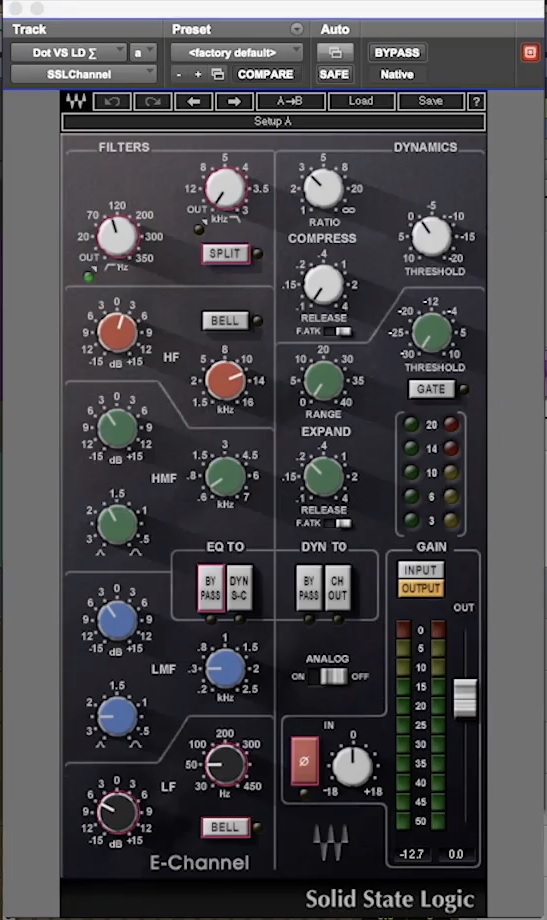
The channel strip is used to reduce problematic frequencies on the vocal.
The vocal EQ settings start with a high-pass filter around 100 Hz.
There’s also a low-end cut at 50 Hz, using a shelf filter, to reduce rumble and any mic noise.
In the midrange, there are two cuts, one at around 300 Hz to reduce muddiness and another at around 600 Hz to fix boxiness.
These midrange cuts reduce any room sound to make the vocals sound cleaner and clearer.
Finally, there’s a boost around 12 kHz to add some sparkle to the vocal.
In slot two, there’s a Renaissance compressor.
R-Comp
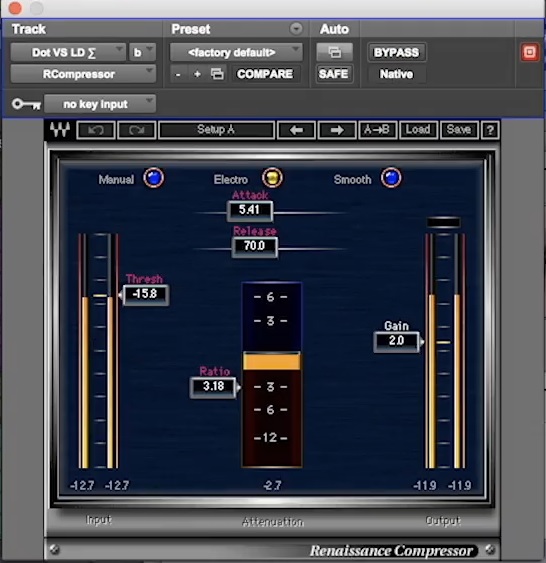
A fast attack and release were used to control the transients.
A small amount of ratio and gain reduction were used.
This style of vocal compression is used to control dynamic range and keep the volume consistent throughout the entire performance.
Waves Q10

The next plugin in the vocal chain is the Waves Q10 equalizer plugin.
The purpose of this EQ is to reduce any room noise.
There’s also a high-pass filter to remove any low-end build-up that the SSL channel strip has missed.
Note that the channel strip is not designed for surgical processing, hence the cut in the low-end.
Waves DeEsser

Next in the chain, we have a DeEsser to take care of the sibilance.
The plugin frequency parameter is set at 8 kHz because that's where Kendrick’s voice tends to sound sibilant.
Nothing much to say here, it's a de-esser and it tames harsh frequencies.
LA-2A Comp/Limiter

The LA-2A was used to apply more compression.
This compressor doesn’t only control dynamics; it also adds character to Kendrick’s voice.
Notice that it is set to Limiter instead of Comp. This makes the plugin use a higher ratio to clamp on any loud peaks.
The internal sidechain (emphasis parameter) is used to make sure that all frequencies are compressed equally.
Pultec EQ
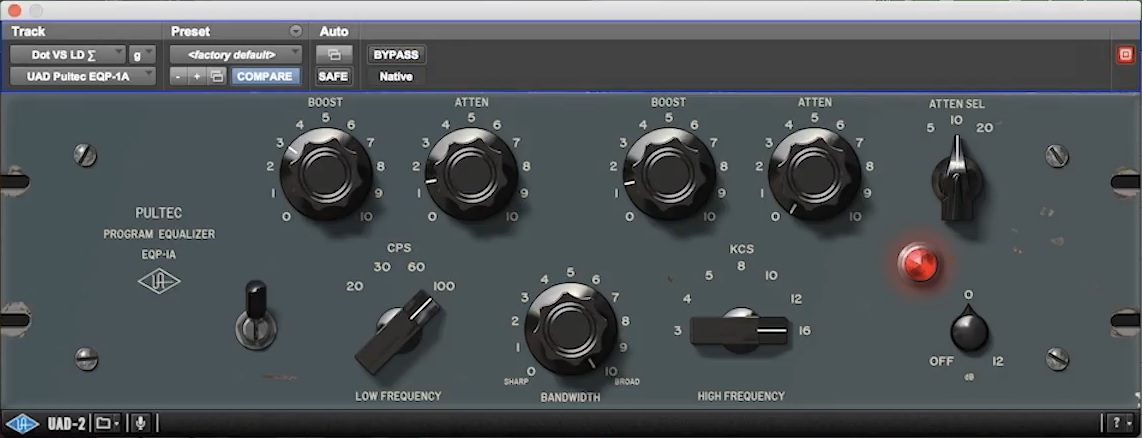
The Pultec EQ is used to do the “Pultec Style EQ” technique, which will boost and cut at the same time.
This adds some warmth to the voice without making it sound boomy or muddy.
There’s also a small boost in the top-end (at 16 kHz) to add some sheen and air to the vocals.
Also, note that a broad bandwidth was used in this case.
Decapitator

Next up in the chain, we have the Decapitator from Soundtoys.
This plugin is used to add saturation and an analog feel to the voice. The “A” type was chosen.
This is modeled after the Ampex 350 tape drive preamp.
It gives the voice a smooth sound.
Pro-Q 2

Finally, the Pro-Q is used to reduce sibilance at 4.5 kHz.
Apparently, Kendrick's voice usually sounds too sibilant at this frequency.
There’s also a boost in the top-end to compensate, or else the vocals could sound dull.
Effects
For the effects, I couldn’t get all the images.
But the effects that were used are a hall reverb (with a flanger on the return), an EMT plate, and a delay effect (Soundtoys Echoboy).
The delay effect was automated during certain parts of the vocal performance.
And, that's how Kendrick's lead vocal on "All The Stars" was mixed.
Let's move on to the next song.
The Weeknd - Alone Again | Vocal Chain
The Weeknd's 'Alone Again' is a hauntingly immersive journey into the depths of his signature dark, introspective R&B.
The song opens his 'After Hours' album with an eerie, synth-laden atmosphere that perfectly sums up the album's themes of loneliness and introspection.
The Weeknd's high-pitched vocals are emotive and raw, drawing the listener into the isolation he portrays.
The song was mixed by Carlo Montagnese, aka Illangelo.
Let’s explore the lead vocal chain, one plugin at a time.
Fabfilter Pro-Q

The first plugin in the chain is the Pro-Q from FabFilter.
There's a high-pass filter at 185 Hz, some might consider this to be too high.
Slope filter at 1.5 kHz to lift up the top-end.
Low-pass filter at 13 kHz (at 6dB/oct) to smooth-out the high frequencies a little bit.
Also, note that the EQ is in linear phase mode (medium).
Vocal Rider Plugin
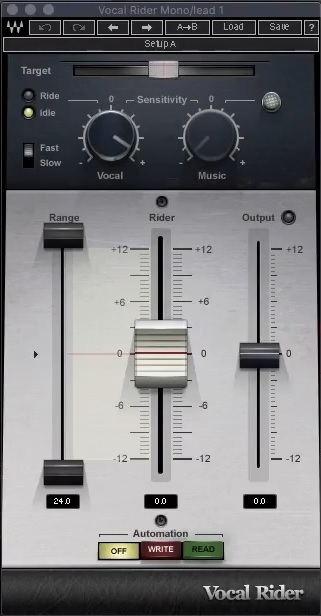
The vocal rider is a great plugin because it doesn’t introduce any compression artifacts.
The plugin gives you the feel of a singer backing off the microphone when singing louder and getting closer to the mic when singing softly.
Basically, it adds movement and emotion to the vocal performance.
This is a great way to prepare the vocal for processing and adding effects.
Pro-G
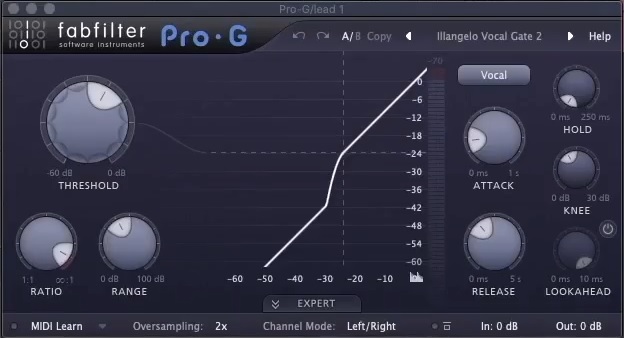
The Pro-G in this chain is used to create downward expansion. Similar to what the Waves R-Vox does (not exactly).
The reason Pro-G was chosen is just for flexibility and more control.
Basically, this technique gives you cleaner vocals.
Instead of using brute-force gating, once the plugin detects there’s no vocal, the output drops smoothly but is ready to kick-in instantly when needed.
DeBreath

The one thing I would recommend is to avoid this plugin.
It has a ridiculous amount of latency.
If you don’t have the time to manually remove breaths (with clip gain), at least use the iZotope DeBreath plugin; it’s much better.
Anyway, in this vocal chain, the DeBreath plugin is used slightly to reduce loud breaths.
Eiosis DeEsser

DeBreath is followed by a DeEsser to tame loud sibilance.
The Eiosis Desser plugin was chosen in this situation. One of the best sounding DeEsser plugins out there.
There’s not much to say about vocal de-essing. It’s a straight forward process.
FabFilter L2

The limiter in this chain is used to control all the loud peaks since compressors are usually not fast enough to do that.
The limiter is set to “safe” mode to avoid digital clipping or introducing unwanted artifacts.
The plugin is only applying around -1 dB of gain reduction.
You don’t want the limiter to clamp down too much on the transients. You just want enough to keep them well controlled.
Pro-MB

The Pro-MB is taking care of the low-end and lower midrange frequencies to reduce any room sound.
This is done using a multiband compressor instead of a static EQ.
This way, you can control the problematic frequencies only when they get too loud.
The top-end also gets compressed in some parts of the song, but most of the time the high frequencies are unaffected.
Basically, the Pro-MB is being used to shape the tone of the voice.
FabFilter Pro-D

This de-esser is not doing much; it’s just taking care of some minor sibilances that were brought up by the compression.
This process keeps the vocals clean and reduces any harshness in the 7-14 kHz range.
So, this De-Esser is not doing the heavy lifting; that’s done by the first De-Esser.
Think of this one as the final polish.
Maag EQ4

The Maag EQ plugin is a favorite for many engineers because of its Air Band feature.
This adds some shine to vocals like no other plugin can.
There's a small boost (0.5 DB) at 20 kHz to lift up the top-end.
There are also two cuts at 160 Hz and the sub frequencies to help reduce boominess in the voice.
Pultec EQP-1A

Another vocal chain that uses the Pultec EQ technique, where you cut and boost at the same frequency.
On this song, it’s done at 100 Hz.
There’s also a cut at 3 kHz to reduce some edginess in the voice and keep it smooth.
Basically, this is final tone shaping for the voice to balance the low-end and high frequencies.
Pultec MEQ-5

The midgrange pultec is used to boost the 1.5 kHz area to bring up the attack of the vocal so that it cuts through.
These two pultec EQs also add tube warmth and character to the vocals.
Oeksound soothe2

This plugin is like magic and has gained a lot of fame among many audio engineers.
In this case, Soothe2 is being used to make frequencies from 250 Hz to 20 kHz sound smoother.
This also reduces any resonant peaks throughout the entire spectrum.
Effects
For the effects, there’s a lot going on as compared to other songs.
Note that all the effects are in an aux channel.
Here’s a list of all the effects:
- Waves Doubler
- Timeless Delay (short slap delay)
- Timeless Delay again (a longer one this time)
- FabFilter Pro-R
These are the main effects, but there are other 6+ more creative effects that only occur in certain parts of the arrangement.
If we cover those, this blog post will never end.
Diplo - On My Mind
Diplo's 'On My Mind' is a vibrant and infectious fusion of electronic and pop elements.
With its catchy beats and lively production, the track exudes a feel-good vibe that's hard to resist.
'On My Mind' is a dancefloor anthem that brings the party to life, making it nearly impossible to get the song out of your head.
The song was mixed by Luca Pretolesi.
Soothe2

On this song, Soothe is being used to catch fast sibilant sounds before any processing.
This results in a clear vocal that doesn’t sound piercing when you start boosting high frequencies or when the song is played loud.
You can never go wrong with this plugin.
FabFilter Pro-Q
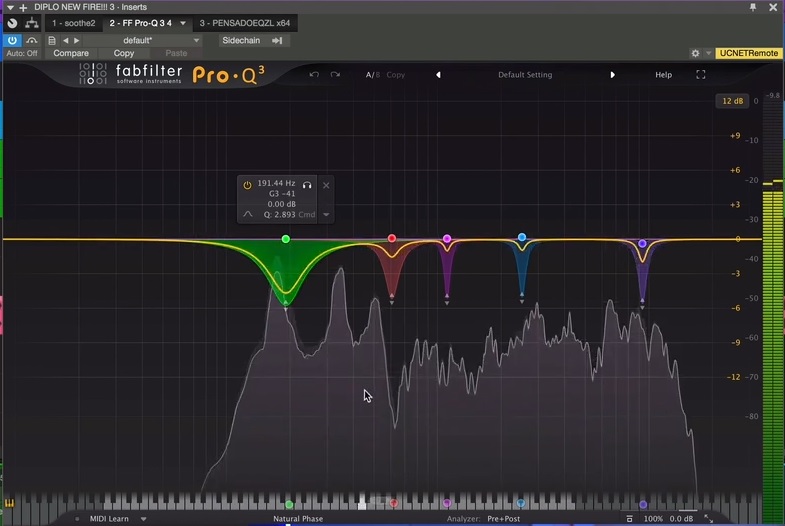
So far, all the tracks above have this plugin on them.
It just goes to show that FabFilter got everything right with the Pro-Q plugin.
For “On My Mind”, the Pro-Q is being used to tame loud resonant peaks.
Dynamic EQ mode was used instead of a static one. This makes sure that the vocal doesn’t sound unnatural.
With so many cuts, the EQ could start introducing phase issues, so that’s why dynamic EQ was the best option.
Pensado EQ
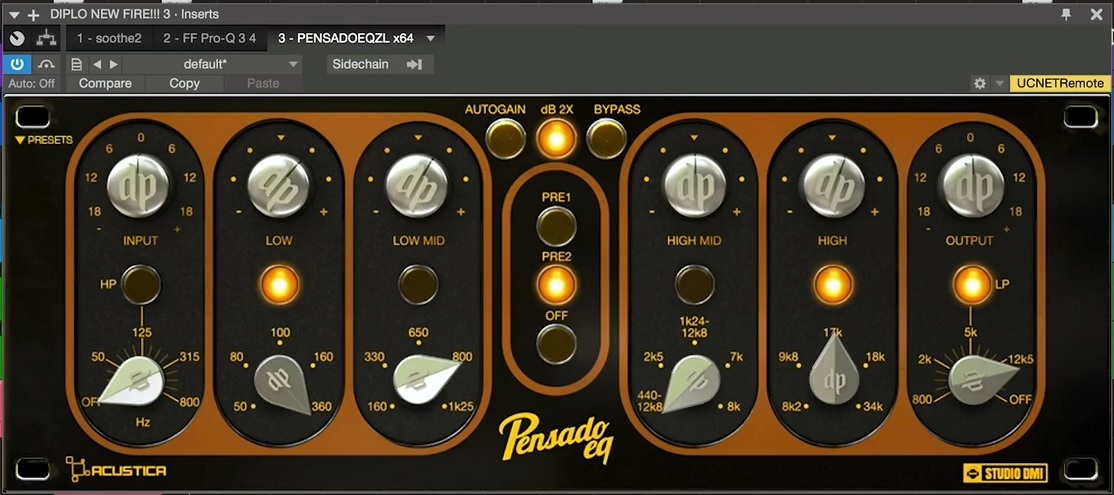
The Pensado EQ was used to add some tone to the vocals.
After removing all the ringing noise, you need to add some vibe, and this is what this EQ gives to the vocals.
There’s a boost at 360 Hz to add some warmth to the voice. To emphasize the attack, Luca created a boost at 800 Hz.
There’s another boost at 17 kHz to add some sheen and sparkle.
Finally, a small cut at 12 kHz. This gives you the Pultec EQ style, where you cut and boost at the same time.
Pro-C

Here’s something that many might think is ridiculous to do.
The Pro-C is doing some sidechaining on the vocal. The crazy part is that the kick drum is the trigger.
This means that every time the kick hits, the vocal will duck.
This gives the vocal a pumping effect and keeps the kick front and center (without overpowering the voice).
Dance music engineers use this technique to create separation, clarity, and emphasize transient responses.
This is how you know that you’re listening to a House Music song.
It’s ecstatic.
Believe it or not, this is the entire vocal chain in Diplo’s voice. As compared to the tracks above, this one has a simple chain.
If you liked this post, you will also want to check out Jaycen Joshua's Vocal Chain.
All the best.